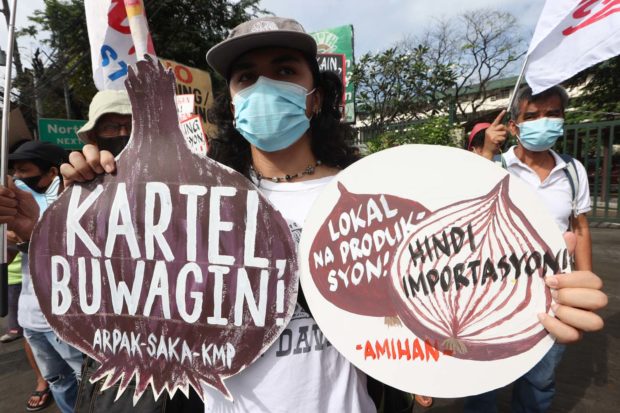Losses driving onion farmers to desperation

FARMERS’ CALL Farmers and groups supporting them gather at the Department of Agriculture office in Quezon City on Monday to call on the government to solve high food prices, support local production, and halt importation. (Photo by NIÑO JESUS ORBETA / Philippine Daily Inquirer)
MANILA, Philippines — Onion farmers have been driven to despair, with some taking their own lives, after bearing the brunt of protracted losses, mounting debts, unscrupulous traders who have made their crops out of consumers’ reach, and the deluge of smuggled onions in the market.
This was the human element, the hard reality, behind the macroeconomic abstraction of rising prices of onions, as senators looking into that matter were apprised of that situation on the ground at their hearing on Monday.
Merlita Gallardo of Bayambang, Pangasinan, the widow of an onion farmer who killed himself in January 2021, recounted to the Senate committee hearing on agriculture how their sustained losses beginning with the pandemic year worsened their anxieties.
“He went far away from the farm to kill himself. Because our debts were piling up, and he didn’t want to borrow [money] anymore. That’s why he began to worry too much,” she said about her husband Roger, 49.
Gallardo’s story served as a “snapshot” of the hardships bearing down on onion farmers who are dealing with the economic toll of the pandemic, the lack of facilities to store their produce, the difficulty of bringing them out to the market, and the competition from smuggled goods soon to be compounded by fresh imports.
Article continues after this advertisementElvin Jerome Laceda, president of nongovernmental organization Young Farmer’s Challenge Club of the Philippines (YFCCP), said his group had learned about four other farmers in Bayambang who were also driven to suicide because of debt.
Article continues after this advertisement“These were young farmers. Hopefully, what became of them will not happen to the others,” he said.
YFCCP has been helping onion farmers cope with low farm-gate prices by buying their produce at P200 a kilo.
“I wish these products were bought at the right price at FTI [Food Terminal Inc. in West Bicutan, Taguig] and other agencies, so consumers won’t be [discouraged from buying],” Laceda said at the hearing.
Sen. Cynthia Villar, committee chair, criticized the government corporation for selling onions at exorbitant prices.
“They (the farmers) were driven to suicide because their debts had piled up and nobody is buying their onions. You should have pity on them,” Villar said.
But FTI president Robert Tan said they were selling onions at P500 a kilo to “stabilize” prices, which prompted the senator to remark: “You’re treating us as if we’re stupid with that kind of reasoning.” Villar also chastised Tan for raising prices before going on leave.
Demand can be met
Senate Minority Leader Aquilino Pimentel III, for his part, commended Ramon Silverio, chair of the provincial cooperative development council of Occidental Mindoro, after he assured the committee that onion farmers can meet the country’s demand.
“I am heartened by what I heard from Mr. Silverio, representing just one province—83,000 metric tons (MT), with the proper motivation and support… [onions] can be supplied by just one province,” Pimentel said.
Sen. JV Ejercito said he would file an amendment to the Anti-Agricultural Smuggling Act (Republic Act No. 10845) to include profiteering, operating a cartel and hoarding as criminal offenses. Ejercito was principal author of that 2016 law. Sen. Risa Hontiveros reiterated her opposition to the importation policy as she called for more “government assistance for irrigation… co-financing cold storage facilities [and] other key areas for improvement.”
“If left unchecked, importation is a double-edged sword, which can slash the already meager earnings of our local farmers and other agricultural workers,” she said.
USDA report
Meanwhile, the United States’ Department of Agriculture (USDA) warned that the Philippines will not be able to meet its importation quota of 21,060 MT of onions, as specified by the country’s Department of Agriculture in its Jan. 6 memo to licensed importers.
In a Jan. 12 country report on the Philippines titled “Temporary Onion Import Plan Expected to Fail,” USDA said the memo’s “extreme conditions” on the importation of 17,100 MT of red onions and 3,960 MT of yellow onions “all but guarantee that it (the quota) will not be filled and likely will not come close to filling.”
Among the conditions specified by the DA’s memo were the limited period for importation (until Jan. 27), the limited number of clearances, the limited ports of entry, and the additional requirement of submitting liquidation reports to the Bureau of Plant Industry.
Furthermore, “[i]mported fresh onions are restricted from being stored anywhere other than the accredited cold storage facilities indicated in their [clearances]. Transfer to other cold stores is strictly prohibited. Red and yellow onions must also be stored in separate rooms,” the report said, citing the memo.
“This combination of factors will further impede the ability of imported onions to access and flow through the local supply chain,” it added.
‘Chinese exporters’
The USDA report said further that, given the “limited volume and tight window of opportunity to apply for import permits [and] several other conditions… [all these will] reduce the likelihood that the…intended result of providing price relief to consumers [will be achieved].”
“Given the time restriction, proximity, and shipping lanes, the [memo] gives strong favor to Chinese exporters over to those in Europe and India,” said the report, which based that projection on imports between October 2021 and September 2022 during which “the Netherlands accounted for 48 percent of imports [to the Philippines], followed by China (30 percent) and India (22 percent).”
“[T]he government’s conditions greatly favor Chinese supplies despite China not being importers’ favored supplier,” it said.
RELATED VIDEO:














